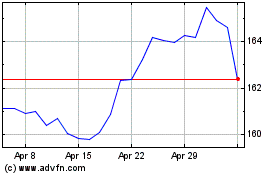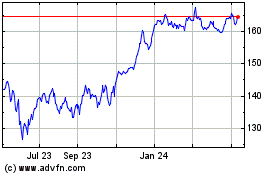T-Mobile Warns Investors of More Costs Ahead as It Digests Sprint
February 04 2021 - 6:00PM
Dow Jones News
By Drew FitzGerald
T-Mobile US Inc. said its nearly year-old merger with Sprint
Corp. will saddle the combined company with more costs this year as
its engineers shift more subscribers onto a single network.
The Bellevue, Wash., company said it would spend $2.5 billion to
$3 billion before taxes folding the stores, employees and network
infrastructure it acquired from its one-time competitor into the
new business. The company spent about $1.9 billion on such expenses
last year.
The added burden pushed T-Mobile's fourth-quarter net income to
$750 million, or 60 cents a share, compared with a year-earlier
result of $751 million, or 87 cents a share. The latest quarterly
result included $686 million of merger costs. Revenue jumped to
$20.3 billion from $11.9 billion a year earlier, before the company
had absorbed Sprint.
T-Mobile closed its purchase of smaller competitor Sprint last
year after a two-year legal campaign that culminated in a federal
court ruling in its favor.
The merger left the U.S. with three major carriers that have
spent the past year fighting each other and a collection of smaller
brands for new customers. T-Mobile in January reported a net gain
of 824,000 postpaid phone connections in the fourth quarter. Rival
AT&T Inc. said it added 800,000 of those prime customers.
Verizon reported a net gain of 279,000 postpaid phone
connections.
T-Mobile also continued adding devices other than cellphones,
including tablet computers and internet hot spots, to its cellular
network. It reported a net gain of 794,000 such postpaid
connections in the fourth quarter.
The carrier said on Thursday that it had made more progress
integrating Sprint's customer base, with 25% of Sprint postpaid
customer traffic already flowing over T-Mobile's systems,
representing about 4 million subscribers.
T-Mobile executives are counting on versatile midrange wireless
airwave licenses gained from the Sprint purchase to fuel their
company's growth for years to come. Engineers have already put some
of the valuable spectrum to work carrying ultrafast
fifth-generation, or 5G, wireless service across much of the
country.
Executives said the added cost of bringing the two companies
under one roof would be more than covered by the future cost
savings from a simpler organization. They also pointed to faster
wireless downloads as a reason the company's revenue will keep
improving.
"We've competed mostly on price in the past, if we're honest,"
Chief Executive Mike Sievert said during a livestreamed conference.
"Now, we have a premium product."
Write to Drew FitzGerald at andrew.fitzgerald@wsj.com
(END) Dow Jones Newswires
February 04, 2021 17:45 ET (22:45 GMT)
Copyright (c) 2021 Dow Jones & Company, Inc.
T Mobile US (NASDAQ:TMUS)
Historical Stock Chart
From Mar 2024 to Apr 2024

T Mobile US (NASDAQ:TMUS)
Historical Stock Chart
From Apr 2023 to Apr 2024
